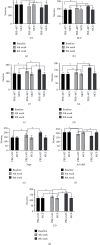Progressive Resistance Exercises plus Manual Therapy Is Effective in Improving Isometric Strength in Overhead Athletes with Shoulder Impingement Syndrome: A Randomized Controlled Trial
- PMID: 34307681
- PMCID: PMC8266437
- DOI: 10.1155/2021/9945775
Progressive Resistance Exercises plus Manual Therapy Is Effective in Improving Isometric Strength in Overhead Athletes with Shoulder Impingement Syndrome: A Randomized Controlled Trial
Abstract
Reduction in isometric strength of the scapulohumeral muscles is a commonly seen impairment in overhead athletes afflicted with shoulder impingement syndrome (SIS). The purpose of this study was to compare the effects of two different treatment programs: progressive resistance exercises plus manual therapy (PRE plus MT) and motor control exercises (MCE), on isometric strength of upper trapezius (UT), middle trapezius (MTr), lower trapezius (LT), serratus anterior (SA), supraspinatus (Supr.), anterior deltoid (A.D), and latissimus dorsi (LD). 80 male university-level overhead athletes clinically diagnosed with SIS were randomly allocated into either of the two groups: PRE plus MT and MCE group. Athletes in the PRE plus MT group underwent graduated exercises with resistance elastic band, stretching exercises, and mobilization of the thoracic and shoulder joints. MCE group was submitted to motor control exercises in varied planar positions. Athletes in both groups underwent management 3 times a week for 8 weeks. Isometric strength of UT, MTr, LT, Supr, A.D, SA, and LD was measured at three-time points: baseline, 4th week, and 8th week. Relative to baseline, both interventions were found to be effective in increasing and optimizing the isometric strength of muscles (p < 0.05) except for supraspinatus in the MCE group (p > 0.05). However, athletes in PRE plus MT group presented a more pronounced increase in isometric strength than those in the MCE group. Between groups analysis found the largest isometric strength improvement in PRE plus MT group for A.D, followed by Supr. and UT muscles (p < 0.05; effect size: 0.39 to 0.40). The study concluded that compared to MCE, PRE plus MT provides greater improvement in the isometric strength of scapulohumeral muscles.
Copyright © 2021 Saurabh Sharma et al.
Conflict of interest statement
The authors declare no potential conflicts of interest with respect to the research, authorship, and/or publication of this article.
Figures


References
Publication types
MeSH terms
LinkOut - more resources
Full Text Sources
Medical
Research Materials

